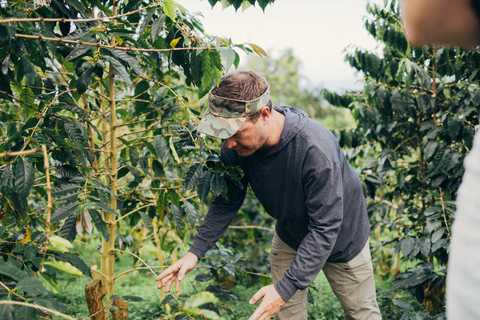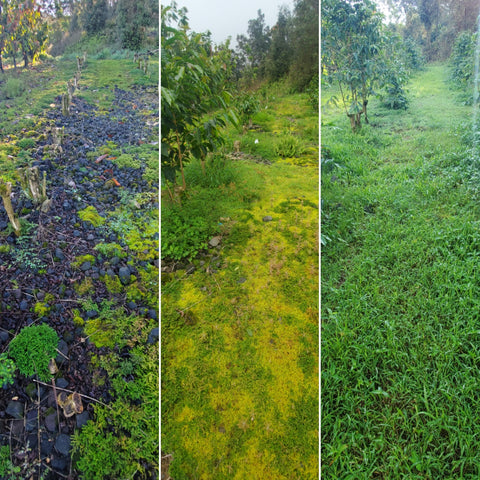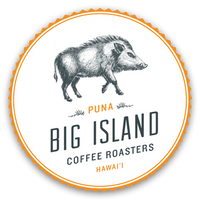"The forest was already there - we're just freeing it up."

Kona Restoration Farm owners Riavh and Johann recently welcomed us to their farm and talked with us about their agroforestry efforts. Their sense of pride and dedication to the land was palpable. While walking their farm with their barefoot two-year-old we felt ignited by a twin flame in our similar values of safeguarding Hawaiian lands and restoring native ecosystems. When you find other companies working towards like-minded goals of a healthier and more sustainable future for coffee, it's almost a no-brainer to partner up. We are proud to introduce their Kona coffee, Kona Restoration Coffee, here with you.
Agroforestry and Biodiversity

Coffee farming is a whole-systems approach, because it's not just about the coffee, but the entire ecosystem. Rivah and Johan's academic backgrounds in ecology lend them a specific wisdom of the whole system in question. In simple terms, you can think of the “whole system” as:
- Understory (grass, wildflowers, weeds, etc),
- Midstory (shrubs, bushes, taller plants),
- Topstory (trees).
A healthy farm has a healthy and balanced ecosystem. So, for example, if a coffee farm is using Round-Up to control weeds in the understory the whole system becomes unbalanced.
In 2019, when Rivah and Johann bought the farm, the land was regularly treated with Round-Up resulting in being largely covered in black lava rock. Their first plan of action was to restore the natural understory by eliminating the use of Round-Up on their farm. Ecosystems are interconnected, so when one branch of the system is restored it creates a chain reaction throughout the other branches of the system. After a few months of not spraying their farm Rivah and Johann saw the results they were hoping for:
Grass returned → Grass breaks down the lava rock over time to create soil → Grass also provides a lush home for insects → Insects thrive, which attracts birds back to the land → Bird droppings provide nutrients to the soil → Nutrient-dense soil results in healthier crops.

Regenerative Farming Practices
With the recovery of the natural understory, Kona Restoration Farms has been successful in fighting soil erosion and slowly restoring the land. The couple's ongoing goal is to create and celebrate biodiversity by clearing invasive species to make room for more native Hawaiian plants. “We attacked the tipuchina and the strawberry guava and then waited for the forest to come back. We didn't plant anything. The forest came back. The forest was already there - we're just freeing it up,” Johann explains. Eventually, midstory plants, like Māmaki, returned to fill in the landscape between the native topstory, like ‘Ōhi‘a, and the grassy understory.
At one point on our tour, Johann sheepishly admits he was saving the best bit for last and excitedly leads us to the tallest Māmaki tree I've ever seen. When he peeled back the branches of the Māmaki I was delighted to see a shiny and healthy patch of coffee trees being shaded by the Māmaki's ever-expanding leaves. This midstory provides an ideal shaded canopy where the coffee trees have a natural protection from UV poisoning; a threat which is all too common for crops surviving the extreme Kona sun. Feeding off the buzz of Johann's excitement, we asked, “Is this the goal for the whole farm? Do you want all of your coffee trees to be planted under the natural midstory?” He looked far away, “Maybe in five years…” he trailed off, “Maybe in ten”.

What Rivah and Johann are doing is a labor of love, but it's also a ton of work. The terroir of the Kona Coffee Belt is made up of hills and lava rock, making it almost impossible to clear everything with the use of large, automatic machinery. The lay of the land requires an intimate touch, one where weed-whacking by hand is necessary to avoid getting into tricky situations like a tractor getting stuck on steep and rocky terrain. The difference between how their soil looked when the couple took over the farm five years ago compared to today is measurable and indisputable. We are so excited to see what Kona Restoration Farm continues to do and hope by amplifying its success, other Hawaiian coffee farmers are influenced to consider reforestation and ecosystem regeneration as well.





